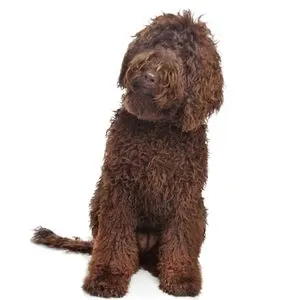If you are reading this post you’re probably thinking about getting a Labradoodle. But which one should you get? Labradoodles come in different sizes, colors and even breeding. It can be hard to decide which is the right pup for you. Join us as we take a look at the Chocolate Labradoodle and all their wonderful qualities. Plus, we will go over a few things that you need to consider before deciding to get one.
Looking for a brown colored dog? Check out our posts on the Bernedoodle, Goldendoodle and Newfiepoo to discover more brown colored doodles.
The Different Types of Labradoodles
Before we get into detailed information on the Chocolate/brown Labradoodle let’s first talk about the different variations you can find in this breed.
1. Labradoodles Types
First there are at least two types of Labradoodles; the American Labradoodle and the Australian Labradoodle.
The American Labradoodle is a cross between a Poodle and a Labrador Retriever. This is a true doodle in the sense that they are two breeds mixed together, with one of the breeds being a poodle.
The Australian Labradoodle’s breeding is more complex. In the 1990’s, after the initial Labradoodles were bred in Australia, Australian breeders looked to produce litters with consistent conformation, coat type and temperament. To do this they introduced the English Cocker Spaniel and the American Cocker Spaniel to the mix.

There were a few other breeds that were used to a lesser extent in the breeding of the Australian Labradoodle, but they have mostly been bred out at this point. Though, these other breeds may still show up in DNA reports for some dogs.
Because the Australian Labradoodle is a multi-generation doodle there is more consistency with what you get. But there is also less Labrador in them.

2. Labradoodle Sizes
Labradoodles come in three sizes. For the American Labradoodle the size is generally determined by the size of the poodle used in breeding and the generation classification. But you often won’t know the true size of your American Labradoodle until they are full grown.
Let me explain. Let’s say you are looking for a mini Labradoodle and you decide you want a first-generation Labradoodle (aka an F1 Labradoodle). This means they are half mini poodle and half Labrador Retriever.
When you mate a mini poodle that is less than 15 inches tall and a small Labrador Retriever that is around 22 inches tall, you may or may not get a mini Labradoodle that is between 14 and 16 inches tall, which is the range for a mini Labradoodle.
They could be as big or bigger than the Labrador or as small as the mini poodle. You will not know which genes are passed down until they are adult dogs. Chances are they will be a little of both. They may have a long body with short legs.
These issues become less of an issue when you are dealing with multi-generation doodles like the Australian Labradoodles. This is because over many generations the genes for a larger sized dog will be bred out if only smaller doodles are used for breeding.
When looking for either Labradoodle, if size is important to you, make sure to ask about the size of the parents, and the two generations before that.
Size ranges for the Australian Labradoodle
- Miniature – between 14 and 16 inches in height
- Medium range – between 17 and 20 inches in height
- Standard range – between 21 and 24 inches in height
Above size ranges are from the Australian Labradoodle Association of America. These size ranges are commonly used for the American Labraoodle too.
American Labraoodles weights can vary based on which breed they take after. Labrador Retrievers tend to have a muscle, stocky build, where the poodle tends to have a leaner, athletic build.

3. Labradoodle Colors
Labradoodles come in a wide assortment of colors including chocolate, yellow and black Labradoodle. But they can be any of the colors that the Labrador Retriever or poodle comes in.
Labrador Retriever Colors
The most common colors of the Labrador Retriever are Black and Yellow. Brown or Chocolate is a less common color.
Rare Labrador colors are Red, White and Silver. These rare colors are not part of the original breed’s colors. There is some speculation that these colors were derived by mixing in a different breed.
Poodles colors include: Black, White, Sable, Silver, Apricot, Gray, Red, Cream, and Brown. They also come in different color patterns like parti, phantom, abstract and sable.

All About the Chocolate Labradoodle
Chocolate Labradoodle Breeding
Like humans, dogs carry genes for every trait. And just like with people each dog parent passes down one gene each to their offspring for each possible trait. These genes can either be dominant or recessive.
In the Labradoodle, the gene that dictates a dog’s fur is brown is recessive. The gene for black fur is dominant.
So, if a Labradoodle inherits one brown fur gene and one black fur gene the dog’s fur will be black. But since the brown gene is recessive, it is possible for a black lab, Labradoodle, or poodle to still carry and pass on the brown gene if they are a carrier.
Since the genes for brown fur are recessive there are only a few ways to breed a brown Labradoodle
1. Breed a brown Poodle with a chocolate Labrador Retriever.
2. Breed a black Poodle with a black Labrador Retriever if they both carry the recessive genes for brown coloring. In this case most of the puppies will have black fur but a few may have brown fur.
3. You can also combine a black dog with the recessive brown gene with a brown dog.
It’s important to note that genes do not solely act on their own. It’s possible for one gene to influence another gene to create a different fur color like in the case of the yellow Labrador.

Chocolate Labradoodle Questions
1. How common are Chocolate Labradoodles?
A brown Labradoodle is less common than the more popular black Labradoodles for two reasons:
- The first has to do with the color preferences of Labrador owners. When the Labrador Retriever was first developed from the St. John’s Water Dog and European hunting dog, owners preferred black dogs over the lighter colored pup. This meant that the black Labrador Retriever was cultivated while breeders tried to breed out the chocolate and yellow labs.
- The second reason is that the genes that result in the chocolate color are recessive. So only two dogs that carry the genes can produce a litter of brown puppies. Even if two chocolate brown dogs have a litter, some will be brown and some could be yellow. This is due to yet another gene that changes the way the black and brown genes are shown.
If you want to learn more about the Genetics of Labrador Coat Color, the Maple Leaf Veterinary Care Center has an easy to understand post on the subject.

2. Are Chocolate Labradoodles rare?
Even though the chocolate Labradoodle is less common that doesn’t mean they are rare. Pet owners fell in love with the chocolate, brown color of the Labrador years ago. In response breeders started to breed them regularly. But unfortunately this means that today’s Chocolate Labradoodles come from a small line to brown labs that were available at the time. Plus brown poodles are fairly common.
3. Do All Chocolate Labradoodles Fade?
You may be wondering if that beautiful chocolate brown puppy you saw will keep their color as an adult. The answer to can a Chocolate Labradoodle’s color fade is yes, but not all do. As I mentioned above some genes influence other genes. In this case, there are genes that control the lightening of a dog’s coat as they age.
Scientists are still discovering a dog’s genome so there have been a few genes that are believed to control the lightening of a dog’s fur. This is a common trait in the Poodle so we know they carry the gene(s) that cause the lightening of a dog’s coat.
A Chocolate Labradoodle’s coat can fade to a lighter brown or even a cream color if they carry the gene for it.
If your dog is going to fade you may see signs of fading as early as 6 months old. Most dogs reach their final adult color between 2 and 3 years old.

Do Chocolate Labradoodles turn gray?
It’s possible for your Labradoodle to inherit the G (progressive graying) locus. This gene affects dogs with black or brown fur, causing their fur to turn gray over time. Dogs with the progressive graying gene will start off with a dark coat color but lighten overtime to a gray color.
Are chocolate Labradoodles good dogs?
With the right training and proper exercise all colored Labradoodles make great dogs and family companions. After all, both the poodle and Labrador retriever have been on the top ten most popular dog breeds for ages.
However, there are some that believe chocolate colored Labrador Retrievers are harder to train, are more hyperactive and may be more aggressive than the yellow or black Labrador Retrievers. This belief stems mainly from anecdotal information of Labrador owners.
Does fur color affect a dog’s personality?
But, there is one study that was published in the journal Applied Animal Behavior Science back in 2014 that seems like it may back up this belief.
In the study, researchers collected data on 1,978 dogs that included their behavior and information on their physical and management characteristics from their owners.
The study found that “Gundogs had higher scores for ‘fetching tendency’ and ‘trainability’ than show dogs or pets.” The study also found that “Chocolate Labrador Retrievers were more ‘agitated when ignored’ and showed more ‘excitability’ than black dogs, and lower ‘trainability’ and ‘noise fear’ than both yellow and black dogs.”
It’s important to note that black Labs are the preferred color of hunters, where chocolate labs are often considered to be only good for show or as pets. The differences in behavior may have more to do with their environment and training than the color of their fur.
The study also went on to say that dogs that were exercised for longer periods showed less aggression, less fear of humans and objects and lower separation anxiety than dogs that were not as active.
In another study, published in the Canine Genetics and Epidemiology in 2019, researchers looked to see if there was a correlation between a dog’s fur color genetics and their behavior.
In this study the results did not “support the suggestion that chocolate-colored Labradors are more hyperactive or aggressive than their yellow or black peers. Chocolate Labradors actually showed less aggression to familiar dogs than yellow Labradors. However, dog trainability declined as the number of copies of the recessive allele responsible for the chocolate coat color increased.” But they went on to say that the sample size needed to increase to validate the findings.

Training requirements of a brown Labradoodle
So, as you can see from our section on “Are Chocolate Labradoodle Good Dogs” training, exercise and environment has a lot to do with how a dog will act as they grow up.
It’s very important that you focus on socializing your puppy in the first few months while keeping them safe until they are fully vaccinated.
You should also start training them as soon as they are with you.
Start by teaching them their name. To do this, call out the name near your puppy. When they look at you to see what is going on give them a small treat. Continue to do this until they have learned their name. Next start on other simple commands like, sit, stay, lay down etc.
Remember that your puppy will benefit from positive reinforcement training, frequent interaction and lots of safe activities.
If you don’t have time to devote to training your puppy, including potty training, you should think twice about getting a puppy. There are plenty of older Labradoodles looking for a home that might already be trained.

Do Chocolate Labradoodles Shed?
A common question is whether a dog’s coat color has any impact on the amount of fur they shed. Currently the answer is no. While there are studies that link a dog’s fur type (either straight or curly, long or short) to the amount of fur they will shed, there is no correlation between shedding and the color of a dog’s fur.
What does affect whether your Labradoodle will shed and how much, is the MC5R-gene and the RSPO2-gene. The combination of these two genes will determine whether your dog will shed a lot or just a little. There is no such thing as a non-shedding dog, just ones, like the poodle, that shed less. There are tests available for both the MC5R and RSPO2 genes.
Before these tests were available, breeders would use a combination of visual clues like fur type, facial fur length and generation classification (first generation vs multi-generation) to determine if a Labradoodle is likely to shed.

Are Chocolate Labradoodles Hypoallergenic?
To answer this question, let’s first start with what causes pet allergies. The current belief is that pet allergies are caused by proteins that are found in a dog’s skin cells, saliva and urine. Coming in contact with any of this can cause a reaction in some people.
But oftentimes it’s the airborne pet dander (small pieces of skin) that a person is exposed to that triggers an allergic reaction.
The next thing to understand is that when something is hypoallergenic, it simply means that the item was “designed to be less likely to cause allergic reactions“.
So, since Labradoodles are bred to shed less than Labradors and shedding is what causes the protein to be airborne, by definition they are considered to be hypoallergenic.
But that does not guarantee that a person with pet allergies will not be allergic. As I mentioned in the beginning, the protein that is believed to cause allergies is also the saliva and urine.
Plus, the regular brushing a Labradoodle needs will expose someone to the dander.
Chocolate Labradoodle Fur Types
The type of fur your brown labradoodle has depends on its breeding.
A true multi-generational Australian Labradoodle should have a single coat that is either fleece or wool in texture. Fur may be wavy, straight or soft spirals, but should not be too thick or dense.
American Labradoodles can have a much greater variety in fur type, depending on their breeding.
First generation American Labradoodles can inherit either the straight fur from the Labrador or the curly coat from the poodle. Or they can have a combination of fur where some parts are curly and some are straight or wavy.
F1B Labradoodles or multi-generation Labradoodles typically have a curlier coat than the first-generation Labradoodles. This is due to them having a greater percentage of poodle genes.
Not sure if you want a Labradoodle, Goldendoodle or Poodle? Check out our posts on Goldendoodle vs Labradoodle: Which is Better? and Standard Poodle vs Labradoodle: A Detailed Comparison.

Are Chocolate Labradoodle’s Healthy?
Because the American Labradoodle is a mix of two dog breeds, long term data on their health and lifespan is limited. So, to see what type of health conditions they may be afflicted with we need to look at the parents.
Below is a list of 10 common health problems for the Poodle and Labrador Retriever based on data from Metlife Pet Insurance.
10 Common Health Problems for the Poodle and Labrador Retriever
| Poodle | Labrador Retriever |
| Addison’s Disease | Obesity |
| Hip Dysplasia | Hip Dysplasia |
| Cushing’s Disease | Osteochondritis Dissecans – soft joints |
| Epilepsy | Eye Disease |
| Bloat | Epilepsy – seizures |
| Allergies – skin allergies | Allergies – environmental allergies |
| Cancer | Bloat |
| Blood Clotting Diseases | Tumors |
| Kidney Disease | Exercise-Induced Diseases |
| Cataracts – usually progress to blindness | Heart Disease |
Hybrid Vigor
Hybrid vigor is a term that breeders like to use about doodles. But hybrid vigor is associated with dogs that have several breeds in them. The belief is that the more diverse genetically a dog is, the less likely they will suffer from genetic health conditions.
Since the American Labradoodle only has two breeds that share some of the same health concerns, it is less likely that they will benefit from hybrid vigor.

Are Chocolate Labradoodles Less Healthy than other colored Labradoodles
A study done in 2018 shows that Chocolate Labrador Retrievers might be more susceptible to certain health conditions than their black or yellow counterparts.
The study included over 30,000 records from the VetCompass™ database on Labradors that received care during 2013. The study found that while all Labradors may suffer from ear infections and skin irritations, Chocolate labs had a greater number of occurrences.
In addition, the study found that the average lifespan of black and yellow Labs was 12.1 years, but for chocolate Labs, it was 10.7.
However, the reason why Chocolate Labs are more prone to certain illnesses is unknown. It may have more to do with the unhealthy breeding practices of the Chocolate Labrador Retriever than the color of the dog.

How much is a Chocolate Labradoodle?
When looking for a Labradoodle you need to first decide if you want an American Labradoodle or an Australian Labradoodle.
They are not the same, but some breeders will call an American Labradoodle an Australian Labradoodle simply because the Labradoodle originated in Australia.
But as I mentioned above, the Australian Labradoodle is a multi-generation doodle that is a mix of three breeds or more. They often cost more too.
The average price for an American Chocolate Labradoodle is around $3,000 and the average price of a brown Australian Labradoodle is around $ 3,500. You can find dogs for more or less depending on where you look and the size of the Labradoodle you are looking for.
Where to find a Chocolate Labradoodle?
If you are looking for a puppy your best bet is to find a breeder that does health testing on their dogs and who sells directly to the new family. Stay away from puppy brokers or any breeder that sells their dogs through a third party like on-line puppy sites or puppy stores.
You can also look for a brown Labradoodle in one of the many Labradoodle rescues.
Chocolate Labradoodle Resources
- Australian Labradoodle Association of America
- Association between coat color and the behavior of Australian Labrador retrievers – Canine Genet Epidemiol
- Dog coat genetics – Wikipedia
- Management and personality in Labrador Retriever dogs – Applied Animal Behaviour Science
- Study: Coat color could mean reduced longevity, increased health risks in some Labrador retrievers
